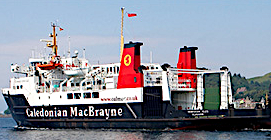State-owned Scottish ferry company Caledonian MacBrayne (CalMac) said that in 2016 it exceeded five million passengers for the first time since 1997 — helped by the first full year of the Scottish government’s policy of reduced rate fares known as “road equivalent tariff” or RET.
Further, the company said Martin Dorchester, Caledonian MacBrayne’s managing director and CEO of the David MacBrayne Group, will remain in his post.
Last May, CalMac won the new £900 million contract to continue operating the Clyde and Hebrides Ferry Services (CHFS) for eight years.
Last October, Dorchester said that having won the new contract he felt the time was right to seek new challenges and he would leave the company in March 2017.
Explaining his change of mind, Dorchester said: “As you will all be aware, Transport Minister Humza Yousaf announced last week that the government will be undertaking a review of Scottish ferry services.
“This review will include applicability of the Teckal exemption, which would potentially remove the requirement to put ferry services out to tender, and the management structures of David MacBrayne Limited (DML) and Caledonian Maritime Assets Limited.
“Having discussed the challenges and opportunities presented by this review with the DML Board and with the Transport Minister, I have taken the decision to stay in my current post and lead the organisation through this new chapter.”
In 2016, CalMac carried 5,055,827 passengers and 1,356,396 cars — 428,801 more passengers than in 2015 and 186,695 more cars.
The strong 2016 passenger numbers were boosted by the first full year of reduced rate fares known as “road equivalent tariff” or RET across the company’s network.
RET is a Scottish government policy to ensure that people living on an island “are not unduly financially disadvantaged by ferry fares.”
The RET scheme involves setting ferry fares on the basis of the cost of travelling an equivalent distance by road.
CalMac operates the UK’s largest ferry network, with 32 vessels carrying out more than 136,000 individual sailings annually across an area which extends 200 miles from Campbeltown on Kintyre and the Isle of Arran in the south, to Stornoway on the Isle of Lewis in the north.
Yousaf said: “These figures underline the success of the full roll out of Road Equivalent Tariff on the Clyde and Hebrides ferry network, a key commitment from the Scottish Government.
“Cheaper fares bring benefits to locals, visitors and local businesses, making ferry travel more attractive and accessible, as well as providing a boost to the tourist trade.
“The Scottish Government is committed to supporting our island communities and ensuring these lifeline ferry services remain affordable for the remote communities that depend on them.”
The busiest route was again the ferry from Ardrossan in North Ayrshire to Brodick on the Isle of Arran, carrying 828,262 people and 202,843 cars in 2016 – a rise of 8.7% and 6.84% respectively.
Two other Firth of Clyde routes complete the top three highest passenger totals with 738,549 (+7.49%) on Largs to Cumbrae and 675,714 (+6.97%) on the Wemyss Bay/Gourock to Rothesay route.
In terms of cars, the Rothesay route was second with 172,897 (+19.12%), with Oban to Craignure on the Isle of Mull showing a 40.66% rise to 162,288.
